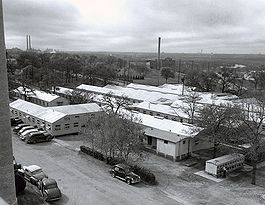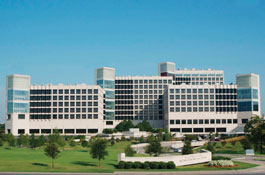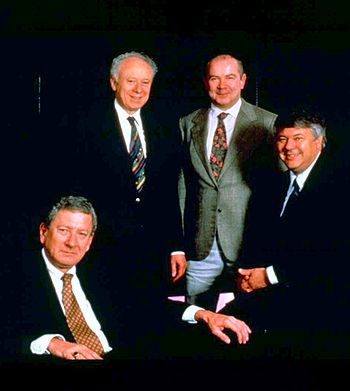|
(Redirected from The University of Texas Southwestern Medical Center at Dallas)
|
|
This article needs additional citations for verification.
Please help improve this article by adding reliable references. Unsourced material may be challenged and removed. (February 2008) |
| The University of Texas Southwestern Medical Center |
 |
| 建立于 |
1943 |
| 类型 |
Public |
| 捐赠 |
$1.37 billion |
| 校长 |
Daniel K. Podolsky, M.D. |
| Dean |
J. Gregory Fitz], M.D. |
| 教职员工 |
3691 (1,394 full-time, 402 part-time, 1,755 voluntary, 110 faculty associates, and 30 administrators) |
| 工作人员 |
7103 |
| 研究生 |
3255 |
| 位置 |
Dallas, Texas, USA
32°48′45″N 96°50′18″W / 32.8126058°N 96.8384102°W / 32.8126058; -96.8384102Coordinates: 32°48′45″N 96°50′18″W / 32.8126058°N 96.8384102°W / 32.8126058; -96.8384102 |
| 校园 |
Urban, 231 acres (0.9 km) |
| 网址 |
www.utsouthwestern.edu |
|
|
University rankings (overall)
|
|
|
The University of Texas Southwestern Medical Center (UT Southwestern or UTSW) is one of the leading academic medical centers in the world. It is the flagship biomedical research institution of the University of Texas System, incorporating three degree-granting institutions, four affiliated hospitals, including Parkland Memorial, the major public teaching hospital of the Dallas/Fort Worth metroplex, and world-class biomedical research laboratories. Its academic and educational prowess was recently reflected by rankings by "US News And World Report", which ranked UTSW's medical school as one of the top 20 in the United States.
UT Southwestern is distinguished by the quality of its biomedical research, which consistently ranks among the best in the world. Shanghai Jiao Tong's Academic Ranking of World Universities places UTSW 6th in the world for the impact and quality of research in the Life Sciences. Thomson ScienceWatch ranks UTSW 7th for the average quality of its research (measured by citations per paper). UTSW's research faculty includes 18 members of the National Academy of Sciences, 13 members of the Howard Hughes Medical Institute, and four active Nobel Laureates.
UT Southwestern's focus on graduate education and its relatively small size have fostered a collaborative culture between basic science and medicine that has led to many major medical discoveries, including Michael S. Brown and Joseph L. Goldstein's Nobel Prize-winning research on cholesterol metabolism. This suitability for training medical scientists is reflected in the emphasis placed on the highly-competitive MD/PhD Medical Scientist Training Program at UTSW, with which Dr. Brown is intimately involved.
The center is located in the Southwestern Medical District, a 231-acre (0.93 km) campus in Dallas incorporating UT Southwestern Medical School, UT Southwestern Graduate School of Biomedical Sciences, UT Southwestern Allied Health Sciences School, and four affiliated hospitals: Parkland Memorial Hospital, Children's Medical Center, Zale Lipshy University Hospital, and St. Paul University Hospital, as well as the Aston Ambulatory Care Center. It has branch programs with affiliated hospitals at several sites in Dallas, Richardson, Fort Worth, Waco and Wichita Falls.
历史

Southwestern Medical College as it appeared at its founding in the 1940s. Animal facilities are seen in the lower right.

The North Campus Research Buildings.
Under the leadership of Dr. Edward H. Cary and Karl Hoblitzelle, a group of prominent Dallas citizens organized Southwestern Medical Foundation in 1939 to promote medical education and research in Dallas and the region. When Baylor University elected to move its school of medicine from Dallas to Houston in 1943, the foundation formally established Southwestern Medical College as the 68th medical school in the United States. Founded during World War II, the medical school was initially housed in a handful of abandoned barracks.
When a new state medical school was proposed after World War II, leaders of Southwestern Medical Foundation offered the college's equipment, library and certain restricted funds to The University of Texas System, provided the university would locate its new medical branch in Dallas. The Board of Regents accepted this offer from the foundation, and in 1949 the college became Southwestern Medical School of The University of Texas. In 1954 the name was changed to The University of Texas Southwestern Medical School. The present campus site on Harry Hines Boulevard was occupied in 1955 upon the completion of the Edward H. Cary Building. This placed the medical school faculty next to the newly built Parkland Memorial Hospital.
In November 1972 the name and scope of the medical school were changed with its reorganization into The University of Texas Health Science Center at Dallas. In approving the concept of a health science center, the Board of Regents provided for the continued growth of coordinated but separate medical, graduate and undergraduate components, interacting creatively on the problems of human health and well-being.
In 1986 the Howard Hughes Medical Institute opened a research facility on the campus. Concentrating on molecular biology, it has brought outstanding scientists to head laboratories in their specialties. These investigators also hold faculty positions in the basic science departments of the medical school and graduate school.
In October 1987 the UT System Board of Regents approved changing the name of the health science center to The University of Texas Southwestern Medical Center at Dallas, reconfirming its original Southwestern identity. The medical center encompasses Southwestern Medical School, Southwestern Graduate School of Biomedical Sciences and Southwestern Allied Health Sciences School.
Since the late 1960s the university has added more than 6,000,000 square feet (560,000 m) of new construction. The 60-acre (240,000 m) South Campus includes sixteen buildings housing classrooms, laboratories, offices, the extensive University of Texas Southwestern Medical Center Library, an auditorium and a large outpatient center. Affiliated hospitals adjacent to the campus are Zale Lipshy University Hospital, Parkland Memorial Hospital, St. Paul University Hospital and Children's Medical Center (Dallas).
In 1987 the John D. and Catherine T. MacArthur Foundation gave the university 30 acres (120,000 m) near the South Campus for future expansion. A 20-year master plan for the site, named the North Campus, calls for six research towers, a support-services building, an energy plant, and underground parking, in addition to the Mary Nell and Ralph B. Rogers Magnetic Resonance Center and the Moncrief Radiation Oncology Center. Three research towers and an elevated campus connector, linking the South Campus with the North Campus, were completed in the 1990s. A fourth 14-story research tower, was completed in 2005. In 1999 the university purchased an additional 50 acres (200,000 m) from the MacArthur Foundation and a portion of the property was used to create an on-campus student-housing complex of 156 apartments. A second phase of 126 units opens in the summer of 2004. After its initial affiliation with Southwestern in 1999, the Moncrief Radiation Oncology Cancer Center has expanded its reach in 2003 with more facilities located in Dallas, Fort Worth, southern Tarrant County, and Weatherford, Texas.
The clinical services are expanding as annual patient visits to the medical center’s clinics average 400,000 a year, up dramatically from only 50,000 annually 15 years ago. In 2003, the American Academy of Arts and Sciences added a 12th member and in 2004 the National Academy of Sciences elected a 15th member from the UT Southwestern faculty to join its ranks.
UT Southwestern Medical School
UT Southwestern is one of the five least-expensive public medical schools and amongst the top ten largest medical schools in the United States. The school's tuition is just over $13,000 per year for in-state residents, being subsidized by the state. By mandate of the state legislature, 90 percent of students are from the state of Texas, in order to assure the state a consistent source of high-quality physicians. For out-of-state residents, the school offers institution grants and alumni scholarships to make up the difference.

UTSW's four Nobel Laureates. L to R: Alfred Gilman, Joseph L. Goldstein, Johann Deisenhofer, Michael S. Brown.
Graduates of UT Southwestern have amongst the lowest amounts of student loan debt at the time of matriculation (average debt of grads from Southwestern is $75,400 according to the 2008 U.S. News and World Report).
UT Southwestern admits approximately 230 students each year and admission is highly competitive. The average MCAT score, science GPA, and undergraduate GPA of UT Southwestern matriculates for 2008 were 33.1, 3.77, and 3.81, respectively. The acceptance rate for 2006 was 13.1%.
UT Southwestern medical students manage The Monday Clinic, a free weekly clinic in East Dallas, under the supervision of Dallas-area physicians. UTSW students also have the opportunity to volunteer at the Agape Clinic, a free weekly dermatology clinic in Dallas, and Camp Sweeney, a summer camp in North Texas for children with diabetes.
Ranking
According to U.S. News and World Report, UT Southwestern ranks 20th in the Nation in the Research category and 20th in Primary Care.
While it is the number 1 ranked medical school in Texas, the U.S. News and World Report ranking does not reflect the scientific reputation of the institution, as it consistently ranks in the top ten US institutions in medical research in other independent rankings of research quality, often well above many of the schools which outrank it on the USNWR list. Shanghai Jiao Tong's Academic Ranking of World Universities places UTSW 6th in the world for the impact and quality of research in the Life Sciences. Thomson ScienceWatch ranks UTSW 7th for the average quality of its research (measured by citations per paper). In an undated survey of federally funded universities in ScienceWatch, UT Southwestern earned a Top 10 ranking in four out of six major fields. Among peer institutions, only Harvard and UCSF received a better overall ranking.
Moreover, UTSW's research faculty includes 18 members of the National Academy of Sciences, 13 members of the Howard Hughes Medical Institute, and four active Nobel Laureates, numbers well above those at some institutions which USNWR ranks in its top 10.
MD/PhD Program
Taking advantage of the world-class research on campus, UT Southwestern runs a highly regarded and competitive MD/PhD program, part of the NIH Medical Scientist Training Program. The program also has a large amount of private funding, allowing them to accept many international students who are ineligible for programs at other institutions that rely solely on NIH funds. The largest source of private support for UTSW's program has been from software billionaire H. Ross Perot, who regularly makes personal appearances during MSTP recruitment events. Dr. Mike Brown has been an advocate for MD/PhD programs, as well as other programs designed to foster the development of future clinician-scientists. Both he and fellow Nobel Laureate Dr. Joe Goldstein are MD-educated basic scientists and often emphasize the importance of a research-oriented medical education for future medical investigators. Dr. Brown is closely involved with the administration of the program, and regularly attends the weekly "Works-in-Progress" talks given by research faculty especially for MD/PhD students. The program is a popular choice for students both because of the strength of the research program and because of the low cost of living in Dallas. MSTP students at most top tier institutions receive a stipend of around $30,000 annually, and most cities with comparable research environments are quite expensive to live in (for example: New York, San Francisco, Boston, San Diego), MD/PhD Students in Dallas are often able to purchase their own homes during their graduate school years, rather than renting, as is the norm for most programs.
Library
The University of Texas Southwestern Medical Center at Dallas Library serves the research, education and clinical information needs of the campus, including the University Hospitals, as well as serving Parkland Health & Hospital System and Children’s Medical Center. The library offers over 62,000 full-text electronic journals and 86,000 books including both print and electronic, as well as about 259,000 print journal volumes. The library’s main physical location on the South Campus offers almost 65,000 square feet (6,000 m) of space with computers for client use, the print book and journal collection, and many study areas. The library also has a small branch library on the North Campus.
Faculty
Notable faculty
UTSW's clinical faculty includes 58 specialists listed in Best Doctors in America and 230 included in Best Doctors in America: Central Region
UT Southwestern currently has four standing Nobel Laureates, more than any other medical school in the United States:
- 1985 Michael Brown
- 1985 Joseph Goldstein
- 1988 Johann Deisenhofer
- 1994 Alfred Gilman
18 members of the National Academy of Sciences
- 1979 Ronald Estabrook, Ph.D. (emeritus)
- 1980 Michael Brown, M.D.
- 1980 Joseph Goldstein, M.D.
- 1983 Jean D. Wilson, M.D.
- 1984 Jonathan W. Uhr, M.D.
- 1985 Alfred Gilman, M.D., Ph.D. (emeritus)
- 1986 Roger H. Unger, M.D.
- 1992 Steven L. McKnight, Ph.D.
- 1994 Ellen S. Vitetta, Ph.D.
- 1997 Johann Deisenhofer, Ph.D.
- 2000 Eric N. Olson, Ph.D.
- 2003 Masashi Yanagisawa, M.D., Ph.D.
- 2003 Joseph S. Takahashi, Ph.D.
- 2004 Xiaodong Wang, Ph.D.
- 2006 Melanie H. Cobb, Ph.D.
- 2006 David W. Russell, Ph.D.
- 2007 Helen Hobbs, M.D.
- 2008 David J. Mangelsdorf, Ph.D.
19 members of the Institute of Medicine
- 1974 Donald W. Seldin, M.D.
- 1975 Ronald Estabrook, Ph.D.
- 1987 Michael Brown, M.D.
- 1987 Joseph Goldstein, M.D.
- 1989 Daniel W. Foster, M.D.
- 1989 Alfred Gilman, M.D., Ph.D.
- 1994 Jean D. Wilson, M.D.
- 1995 Scott M. Grundy, M.D., Ph.D.
- 1997 Ron J. Anderson, M.D.
- 1998 Carol A. Tamminga, M.D.
- 1999 Kern Wildenthal, M.D., Ph.D.
- 2001 Norman F. Gant, M.D.
- 2001 Eric N. Olson, Ph.D.
- 2004 Helen Hobbs, M.D.
- 2005 Steven L. McKnight, Ph.D.
- 2006 George Lister, M.D.
- 2006 Ellen S. Vitetta, Ph.D.
- 2007 Luis F. Parada, Ph.D.
- 2009 Daniel K. Podolsky, M.D.
14 members of the American Academy of Arts and Sciences
- 1974 Donald W. Seldin, M.D.
- 1981 Michael Brown, M.D.
- 1981 Joseph Goldstein, M.D.
- 1982 Jean D. Wilson, M.D.
- 1988 Alfred Gilman, M.D., Ph.D.
- 1992 Daniel W. Foster, M.D.
- 1992 Steven L. McKnight, Ph.D.
- 1993 Jonathan W. Uhr, M.D.
- 1994 Roger H. Unger, M.D.
- 1998 Eric N. Olson, Ph.D.
- 2000 Joseph S. Takahashi, Ph.D.
- 2003 Ellen S. Vitetta, Ph.D.
- 2006 Helen Hobbs, M.D.
- 2007 Luis F. Parada, Ph.D.
13 Members of the Howard Hughes Medical Institute
- Lora Hooper
- Youxing Jiang
- Hongtao Yu
- Zhijian “James” Chen
- Johann Deisenhofer
- Nick V. Grishin
- Helen Hobbs
- Beth Levine
- David J. Mangelsdorf
- Michael K. Rosen
- Joseph S. Takahashi
- Xiaodong Wang
- Masashi Yanagisawa
Affiliated healthcare institutions
Major affiliations:
- Parkland Memorial Hospital
- Children's Medical Center Dallas
- University Hospital-Zale Lipshy
- University Hospital-St. Paul
- Dallas Veteran Affairs Medical Center
Minor affiliations:
- Richardson Regional Medical Center
- Baylor University Medical Center
- Presbyterian Hospital of Dallas
- Texas Scottish Rite Hospital for Children
- John Peter Smith Hospital of Fort Worth
参考文献
- ^ http://www.utsystem.edu/osm/compacts/2009/UTSWMC10-11Compact.pdf
- ^ UT Southwestern Fact Sheet
- ^ http://www.arwu.org/ARWUFIELD2009LIFE.jsp
- ^ http://sciencewatch.com/dr/sci/08/may25-08_4/
- ^ http://www8.utsouthwestern.edu/utsw/cda/dept117179/files/117281.html
- ^ http://www8.utsouthwestern.edu/utsw/cda/dept117179/files/117281.html
- ^ http://www8.utsouthwestern.edu/utsw/cda/dept117179/files/117281.html
- ^ http://www8.utsouthwestern.edu/utsw/cda/dept117179/files/117281.html
- ^ http://www8.utsouthwestern.edu/utsw/cda/dept117179/files/117281.html
- ^ http://www8.utsouthwestern.edu/utsw/cda/dept117179/files/117281.html
- ^ http://www8.utsouthwestern.edu/utsw/cda/dept117179/files/117281.html
- ^ http://www8.utsouthwestern.edu/utsw/cda/dept117179/files/117281.html
- ^ http://www.utsouthwestern.edu/utsw/cda/dept20676/files/397484.html
- ^ http://www.arwu.org/ARWUFIELD2009LIFE.jsp
- ^ http://sciencewatch.com/dr/sci/08/may25-08_4/
- ^ Skolnick AA. "Thanks to gift from Ross Perot, University of Texas Southwestern's MD-PhD Program triples in size." JAMA. 1993 Apr 7;269(13):1607, 1611.
- ^ Library Facts and Statistics--UT Southwestern Medical Center Library. Retrieved on 8 June 2009.
- ^ http://www.utsouthwestern.edu/utsw/home/about/awards/index.html
- ^ http://www.utsouthwestern.edu/utsw/home/about/awards/index.html
- ^ http://www.utsouthwestern.edu/utsw/home/about/awards/index.html
- ^ http://www.utsouthwestern.edu/utsw/home/about/awards/index.html
- ^ http://www.utsouthwestern.edu/utsw/cda/dept353744/files/465759.html
External links
- UT Southwestern Medical Center website
- UTSW MSTP 网址
- The Immunology Database and Analysis Portal - an NIAID-funded database resource of reference and experiment data covering the entire immunology domain
- Influenza Research Database – Database of influenza genomic sequences and related information.
- Virus Pathogen Resource – Virus Pathogen Resource.
|
|



